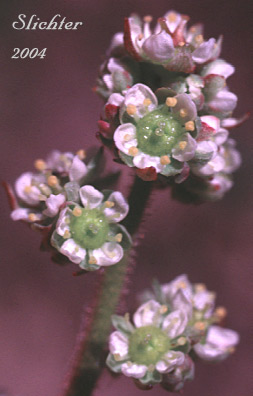 The
photo at right shows a close-up of the flowers of swamp saxifrage, Fish Lake,
Steens Mt.
The
photo at right shows a close-up of the flowers of swamp saxifrage, Fish Lake,
Steens Mt.
Swamp saxifrage is an attractive perennial wildflower with a single erect stem, from 15-25 cm high arising from a cluster of basal leaves. The stems lack leaves and are unbranched (except as part of the inflorescence). The stems and leaves are sparsely to densely covered with white to pink spreading hairs tipped with pink to purple, sticky glands. The leaves are rhombic-ovate to lance-elliptic in shape tapering fairly abruptly to the short to long petioles. The thick blade is usually 2-4 cm in length, but may occasionally reach as long as 6.5 cm. The width ranges from 1-3 cm wide but on occasion, may be as much as 4.5 cm. The leaf margins are usually entire, but occasionally may be lightly toothed. The margins, especially of the petioles, are often fairly densely ciliate.
The inflorescence is a cymose-panicle of 25-50 flowers and ranges from 0.5-8 cm long. The inflorescence ranges from fairly congested to fairly open, with 5-9 ascending to spreading lateral branches. The lowest bract of the inflorescence subtends the lowest branch and is up to 2.5 cm long. The pedicels are 0.5-2.5 mm long and are usually glandular-pubescent with red or purple glands. The calyx is shallowly cup-shaped with 5 glabrous, spreading to reflexed sepals, each triangular-ovate in shape with rounded tips. The 5 petals may be white, yellowish, or greenish-white in color and range from 0.7-2.3 mm long and 0.6-1.8 mm wide. The petals of variety nidifica typically are less than 2 mm long and as long as or shorter than the sepals. They range from linear, elliptic, ovate, or obovate in shape. The 10 stamens are up to 0.6 mm long, each opposite a petal or sepal.
var. claytoniifolia (S. integrifolia var. claytoniaefolia ): The leaves are all basal, the blades broad and abruptly narrowed to the petiole (which is often as long as the blade), the margins generally entire. The petals are white and generally longer than the sepals. Found east of the Cascade Mts. from Okanogan County in Washington south to southern Oregon and east to southeastern Washington, northeastern Oregon, and western Idaho. Also found west in the Columbia River Gorge to the Willamette Valley of northwestern Oregon.
var. nidifica (S. integrifolia var. columbiana & var. leptopetala): Leaves all basal with entire margins, the blades rhombic-ovate in shape, narrowed to slender, weakly ciliate or glabrous petioles. . Inflorescence is a cyme with 3-9 branches. The petals are white to greenish-white, up to 2 mm long, and generally shorter than the sepals. Found in the Blue and Wallowa Mts of northeastern Oregon and southeastern Washington, central and southwestern Idaho, and south through southeastern Oregon to northern Nevada and northeastern California.
Swamp saxifrage at one time was classified as a member of northwestern saxifrage (S. integrifolia), which consisted of 5 separate varieties. Currently, 4 of the varieties have been split from S. integrifolia. Varieties claytoniaefolia, columbiana and leptopetala are now accepted as varieties of S. nidifica. Var. apetala makes up its own species, as does var. integrifolia.
Petalless Saxifrage Saxifraga apetala (S. integrifolia var. apetala): Leaves entirely basal, rhombic-lanceolate in shape, narrowed gradually to the wide, ciliate-pilose petioles. The inflorescence is very congested and capitate. The petals are lacking or very much reduced, yellowish or greenish-white if present. Found east of the Cascade Mts. from Okanogan County south to Yakima County in Washington and in the Steens Mt. in southeastern Oregon.
Northwestern Saxifrage Saxifraga integrifolia var. integrifolia: Early spring wildflower to 18 inches tall. Leaves are basal, oval or elliptical in shape, with entire margins. The blades narrow gradually to the short petiole. The flowers are white and generally longer than the sepals. Common in moist banks and seepage slopes which dry out during the summer. Found mostly west of the Cascade Mts. but extending up the Columbia River to Wasco County in Oregon.
Swamp saxifrage may be found in moist meadows and gravelly slopes in the subalpine and alpine zone in the mountains. It may be found between the elevations of 670-3200 meters.
Swamp saxifrage may be found from the Blue and Wallowa Mts. of southeastern Washington and northeastern Oregon south to the Steens Mt. of southeastern Oregon, and further south to northern Nevada and northeastern California. It may be found eastward to central and southwestern Idaho. Variety nidifica may be found from southeastern Oregon east to southwestern Idaho and south to northern Utah and northern Nevada.
The photo above shows the basal leaves of swamp saxifrage as seen in moist areas in the scablands near Odessa, WA...................April 28, 2007.
